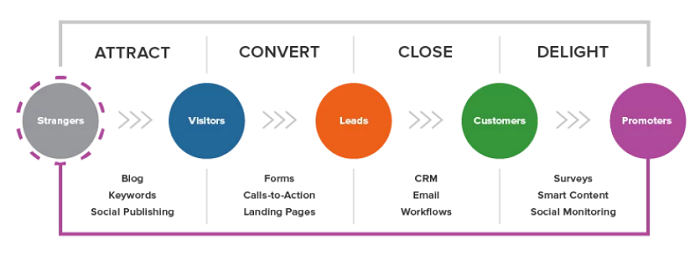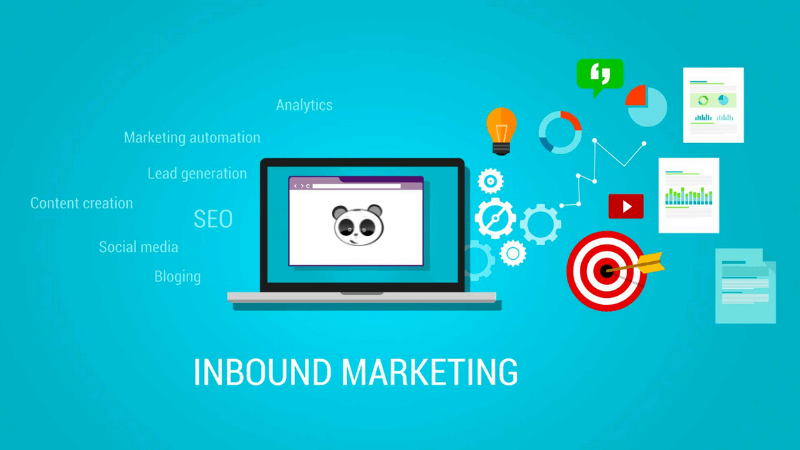What Is InBound & OutBound Marketing: Definition, Pros and Cons, Strategies and More
 |
| What Is Inbound Marketing: Definition, Pros and Cons, Strategies and More . Photo: Advertising Vietnam |
Inbound Marketing might be a strange subject for a lot of people who are new to the marketing and PR field, wish to learn more about this.
When you come across marketing and investment, you will see the phrase “Inbound Marketing” a lot of times. It can be confusing to many people, and in the article below, we will discuss more on its definition, advantages and disadvantages, methodology, and what is the best choice for you.
Inbound Marketing: Definition
 |
| Photo: Callio |
The Internet and social media have forever changed the way companies search for new clients. It leveled the playing field, allowing even small startups to fight for the spotlight alongside big, consolidated brands.
But more opportunities also mean more competition. So how can you make your business be seen by a broader audience and attract new clients with less money to invest?
Inbound marketing is a business methodology that attracts customers by creating valuable content and experiences tailored to them. While outbound marketing interrupts your audience with content they don’t always want, inbound marketing forms connections they are looking for and solves problems they already have.
What is the Inbound Marketing Methodology?
 |
| Photo: Neil Patel |
The 4 stages of the inbound marketing methodology are Attract, Convert, Close, and Delight. Following these steps will steer consumers away from being strangers and toward being promoters of your brand! At each stage, there are specific methods by which this conversion is achieved. It is important that your marketing actions are timely and targeted, and this is what the methodology aims to help you accomplish.
STEP 1: ATTRACT
As with most budding relationships, the first step is attraction. As a business, you want to draw in individuals who can potentially become your customers. These individuals are called buyer personas, and they are at the center of your inbound marketing efforts. Attracting your buyer personas requires a focused inbound marketing strategy that starts with quality content creation. This content needs to not only draw your personas in but also compel them to transition to the next step of the conversion process.
STEP 2: CONVERT
After you have attracted your buyer personas to your brand, the next step is converting them into marketing qualified leads (MQLs). This requires lead nurturing, and to begin the process you will need to obtain the contact information of your site visitors. Contact information is currency to the inbound marketer. The challenge is going about obtaining it.
You need to offer something of value to your buyer persona for them to be willing to relinquish their contact details. This “something of value” comes in the form of content – eBooks, whitepapers, blog posts, webinars, etc. – essentially any sort of materials that your audience would find valuable.
STEP 3: CLOSE
The next step in the inbound marketing methodology is “closing” your leads and turning them into happy customers. Because this goal is consumer-focused, the process is typically a joint sales and marketing effort. Your leads should become “sales-qualified” and ready to buy by the end of this step.
STEP 4: DELIGHT
With inbound marketing, you don’t abandon your customers once they have made a purchase. Your goal is to establish brand loyalty, and in order to do so, you need to continue to show your customers that you still value them.
What does Inbound Marketing do?
The idea behind Inbound Marketing is to create content and experiences that are both interesting and useful to the target audience. So instead of actively reaching out to them, the strategy is to become present in their online life, offering help whenever they need it — even if they don’t want to purchase something right now.
All the companies that understand the value of relationships and emotional connections with potential clients use Inbound Marketing these days. This means that companies are interacting and engaging on social media and providing relevant information on topics that may interest potential buyers, which also creates a voice and a face for the brand.
A great Inbound Marketing strategy achieves the following milestones:
the company improves lead generation and lead quality;
the company’s website increases the traffic from organic sources;
the contents rank better on search engines (especially Google) and the brand is more visible;
conversion rates are increased so the company sells more, spending less;
marketing ROI improves overall.
All these positive results are achievable by any kind or size of business. You just need the right tools and the right plan
The Five Fundamentals of Inbound Marketing
 |
| Photo: Mona Media |
To better understand inbound marketing, it is important to know the five fundamentals of inbound marketing which are traffic attraction, conversion, marketing automation, loyalty, and analysis, according to Cyberclick.
1. Attracting Traffic
The first step is to attract users to the brand's website. However, instead of seeking to generate visits in a massive way, focus on bringing quality users to the website, users who match your ideal client profile or buyer persona.
This can be achieved through a variety of techniques such as:
SEO: if you work on positioning your website within the first spots of major search engines, it will appear as a response to the user's needs at the right time.
Content Marketing: offering users valuable content at the moment they need it will reinforce the process.
Social networks: using them as diffusion channels to help your content reach users.
2. Conversion
Once a user has reached your website, you want them to leave their data, thereby becoming a lead and continuing to receive information from you.
To convert users into potential customers, the classic strategy is to provide them with valuable content in exchange for leaving their data in a form. But there are many other options, such as offering test demonstrations, meetings, or interacting with them through a phone call or chat. In any case, the objective will always be to get their data and add their information to your database.
3. Marketing Automation
This pillar of inbound marketing is based on systematizing the process by which you communicate with your leads until they become customers. For this, you can use techniques such as:
Lead scoring. A technique based on designing an evaluation system that allows you to objectively assess the likelihood of a lead becoming a client.
Lead nurturing. Based on the score obtained and the characteristics of the lead, you design a series of automatic flows to send relevant information to your contacts according to their needs.
4. Loyalty
The process does not end when you manage to convert a lead into a client. The next step is to get this client to stay with you for as long as possible as a result of loyalty strategies, such as newsletters, offers, and incentives.
Designing an effective loyalty strategy is very beneficial for the company, since maintaining a client is much less expensive than acquiring a new client from scratch.
5. Analysis
No inbound marketing strategy is complete if you do not have a plan to measure and analyze the results. For this, you will have to carefully define the KPIs (key performance indicators), which are the most relevant metrics to assess whether your strategy is succeeding or not.
It is also necessary to establish periodic controls to analyze the results and adjust previously established actions if needed. This will improve your inbound strategy.
Inbound Marketing vs Outbound Marketing: What is the difference?
 |
| Photo: Inbound Marketing |
There are several main differences between inbound and outbound marketing. Outbound marketing involves proactively reaching out to consumers to get them interested in a product. By contrast, inbound marketing centers on creating and distributing content that draws people into your website.
Outbound marketing typically has a more aggressive, wide-sweeping approach, with the expectation that at least some people will convert. Inbound marketing is usually more subtle and focuses on convincing a particular group of individuals to make a purchase over time. Here are a few other differences at a glance:
| Inbound Marketing | Outbound Marketing |
|
|
Outbound Marketing:
Outbound marketing sends a message to a massive amount of people in the hopes of making a sale. This strategy is rooted in the thought that the larger the group you message to, the larger the return. Outbound marketing is often associated with traditional marketing, like direct mail, events, billboards, cold calling, newspapers, and radio. However, outbound marketing can also be applied to more modern technology, like pay-per-click advertising and spam emails.
Frequently, consumers are not even aware of or looking for the product that’s being advertised. Prospects could be watching TV or perusing a website and being interrupted by an ad illustrating why they should buy a certain product.
The Benefits of Inbound Marketing
There are several benefits to inbound marketing that can help you determine if it’s the right strategy for your company:
Inbound marketing is non-invasive — prospects can read your blog posts or attend a webinar on their own time.
Inbound marketing content is educational — it’s specifically designed for each stage in the sales funnel.
Inbound marketing is quantifiable 一 you can tie each part of your strategy to a metric that gets monitored over time.
Your website and content are continuously being updated, so Inbound marketing continues drawing in qualified leads over time.
The Benefits of Outbound Marketing
Outbound marketing has a few perks that should not be overlooked:
Outbound marketing promotes brand awareness, helping you reach people who haven’t heard of your products or services before.
Outbound marketing can yield immediate results 一 people interested in your products and services are likely to take action on your ads and make a purchase.
Consumers are accustomed to outbound marketing 一 they know that there will be ads in the Sunday paper or on TV and may trust those ads more than the ones presented to them on newer technology.
The Challenges of Outbound Marketing
Outbound marketing can be difficult to get right. Here are some disadvantages to going the outbound marketing route:
It’s difficult to make outbound marketing appealing and relevant to everyone, so outbound marketing is more generalized.
It’s easy for consumers to tune out outbound marketing 一 many people mute the TV during commercials or immediately throw out or recycle their junk mail.
It’s challenging to measure the effectiveness of some outbound marketing strategies like billboards.
Outbound marketing is costly, traveling to trade shows, paying for banner ads, and purchasing billboard spaces add up.
Overall, outbound marketing is all about sending a message at scale, while inbound marketing has a very targeted approach. The likelihood that at least some people will convert from your outbound marketing efforts is high, but it is often associated with a high acquisition cost. Rather than shouting your product’s name from the rooftops and hoping that a few people respond, inbound marketing content can be finely tuned to appeal to your best-fit prospects.
Pros and Cons of Inbound Marketing
Pros
Transitioning from annoying to helpful
You get to stop being annoying with your marketing and start being helpful. It’s a complete psychological shift with your buyers. You’re not interrupting and pushing yourself on them like you are with outbound. You’re positioning yourself strategically ahead of time so that you’re there when someone needs you. That’s a bigger deal for a company than it might seem on first blush, and it can impact your culture significantly in the long run (in a good way). Human nature is such that most people would much rather be helpful than annoying.
Obtaining feedback from the market
Inbound can provide useful market feedback. As you attract people to you, you’ll start to see what resonates and what misses the mark with your potential customers. You’ll see this at a pretty detailed topic level. You also get a better understanding of the intent behind different searches. It’s a great way to experiment and learn from the market.
Forcing reality
Inbound forces you to be more realistic as to where you stand in the marketplace, and to focus your efforts accordingly. You’ll see pretty quickly some areas where you shouldn’t try to compete. That’s actually useful to learn sooner rather than later where to put your energy and effort so you don’t waste as much time. After you’ve got some experience doing inbound, you’ll start to be able to recognize some cases in which you probably shouldn’t even bother wasting hardly any time at all, maybe not even experimenting. That’s a beautifully efficient reality.
The all-important niche
You have to have one (or several). You have to be looking at your solutions through the eyes of your customer, the way they see their problem (see why you need a niche and what to do about it for more). That doesn’t mean you can only do one thing as a company. You can. You just tackle them semi-independently. Also, your digital footprint doesn’t need to exhaustively cover everything you do as a company.
Cons
Despite all of the advantages of this strategy, there are numerous drawbacks that companies should be aware of. These include:
Campaigns require a constant time investment to produce content that is of sufficient quality to be useful. The efficacy of an inbound campaign only becomes evident three months after the campaign is established, and results may be more difficult to measure.
Requires a strong and diverse skill set, including Web design, content writing, SEO, and social media expertise. A small company with a tiny marketing team may struggle, as the expectation that one person will have all these skills is relatively unrealistic.
Tracking return on investment can be difficult without the implementation of Web analytics to determine how effective an inbound campaign is.
Average Conversion Rate of Inbound Marketing: What is it?Most experts generally agree on a more conservative number of 1% – 3% conversions on your total website traffic. An obvious conclusion is that if you have 300 visitors a month, you should expect 3 conversions at a 1% rate. But the power of even a single-digit percent change in conversions – the kind that can be yielded by conversion rate optimization and a hard look at your content – could change that number to 6 –twice the conversions. As you can see, conversions scale quickly, making optimizing your conversion channels a rather important (and lucrative!) undertaking. It’s a tough number to measure – because there are so many different channels. For example, experts agree that an average conversion rate for email marketing is 1% - 5%, while conversion rates on social media and SEO are very difficult to measure because they rely so much on what happens on your website. Conversion rates are also going to vary heavily from industry to industry depending on competition, commitment level required by the buyer, and so on. Even so, it’s helpful to have an idea of what you might expect from an inbound marketing campaign. Inbound marketing can generate all sorts of leads – but if no time is invested in identifying your conversion funnel (which alarmingly 68% of B2B businesses have not), creating content for the buying cycle to attract more leads or testing your user experience with tools like eye-tracking and click-heatmaps, you could be missing out on the full return. |
 What is The Favela Stock Exchange in Brazil? What is The Favela Stock Exchange in Brazil? Brazilian favelas (or slums) have created their own stock market, which community leaders see as a mechanism to boost local firms and attract investment from ... |
 What is Christmas: History, Meaning and Tradition Around the World What is Christmas: History, Meaning and Tradition Around the World Christmas has become an annual holiday commemorating the birth of Jesus Christ, which is celebrated on December 25. Many people, however, might be curious about ... |
 What Is The Smallest Car In The World: Peel P50 What Is The Smallest Car In The World: Peel P50 Is the world’s smallest car also the continuation market’s biggest bargain? We squeeze into the ‘new’ Peel P50 microcar to find out! |
 What Is The Most Expensive Piece of Jewelry Ever Made? What Is The Most Expensive Piece of Jewelry Ever Made? Tiffany & Co. has released its most expensive piece of jewelry. How much does it cost and what special features does it own? |


























